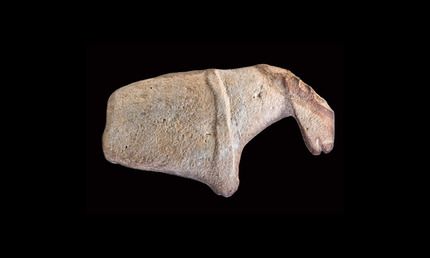A Thousand Years of Art Under China’s Emperors
/https://tf-cmsv2-smithsonianmag-media.s3.amazonaws.com/filer/Horse.jpg)
Dr. Joseph Chang sees the new exhibition, Masterpieces of Chinese Painting at the Freer Gallery as a classroom. And with more than a thousand years of Chinese art on display, the show certainly represents a survey course for the uninitiated.
Last week, Chang, who is a Freer curator of Chinese Art, gave me a tour of the exhibition and I was introduced to hundreds of years of Chinese art history, from the Northern Song dynasty (960-1279) to the Qing dynasty (1644-1911).
Arranged chronologically, the exhibition gives visitors a sense of how Chinese art developed over time, from the portraiture of early Song dynasty China (the earliest work on display is a hanging scroll from 968, depicting the Bodhisattva Guanyin of the Water Moon that was discovered in a Buddhist cave complex in the early 20th century) to the semi-abstract works by individualist-school painters of the Qing period. There are examples from each of the three major formats of Chinese painting: hanging scrolls, hand scrolls and album leaves (Chang describes them as “almost like a book you can flip”).

“That is one feature that western paintings don’t have,” he said. The small red markings that are scattered across the paintings are generally not from the artists themselves. They are collectors’ marks, or seals, from each individual who owned the painting, going back hundreds of years. These marks have helped art historians uncover the lineage of these pieces.
In a handscroll entitled, “Horse and Groom, After Li Gonglin” from the Yuan-era (1279–1368), there is a circular seal in the upper right-hand corner belonging to Emperor Qianlong of the 18th century. This emperor is renowned for having assembled the largest collection of Chinese art in all of history. Prominently displayed in the middle of the artwork is the elegant calligraphy set forth by the Emperor, praising the artist, who had died four centuries prior, for his skill in depicting the horse as like that of a dragon or a phoenix, and very powerful.
Calligraphy, noted my tour guide Dr. Chang, distinguishes Chinese paintings from Western art.
And indeed, most of the paintings in the exhibition are beautifully enhanced in calligraphy with poems written by the artists themselves, messages of admiration from friends of the artists, scholars or collectors, and colophons (inscriptions) providing a history of the piece.
“Painting, poetry and calligraphy are considered the three perfections (of Chinese art),” Chang said. “If someone, a scholar or an artist, can do all the three: can compose the poems, can write beautiful calligraphy and do painting and put all the three together that’s three perfections in one.”
That formula, Chang told me, makes many of the 27 paintings in this collection masterpieces.
Chang’s favorite piece is “The Southern Journey” from the Ming dynasty (1368–1644). The handscroll, done by the highly regarded painter, poet and calligrapher Tang Yin, depicts a musician, a friend of the artist, setting out on a journey to the south. He is riding a donkey and followed by a servant carrying his qin (an instrument similar to a lute). The artist and other prominent scholars wrote poems in calligraphy on the piece wishing the musician a safe journey.
“This piece was like a parting gift that he could bring with him to the south, sort of like a ‘painting of introduction,’” Chang explains. “This is better than a letter of introduction. This is a whole painting.”
"Masterpieces of Chinese Paintings" runs through November 28 at the Freer Gallery of Art. This is a must-see exhibit because in order to protect the paintings from light damage, after six months on display, each painting will placed in storage for five years “to rest.”
To see paintings of the Song and Yuan dynasties, from this exhibit and others in storage, the curators at Freer have developed a special online exhibition.